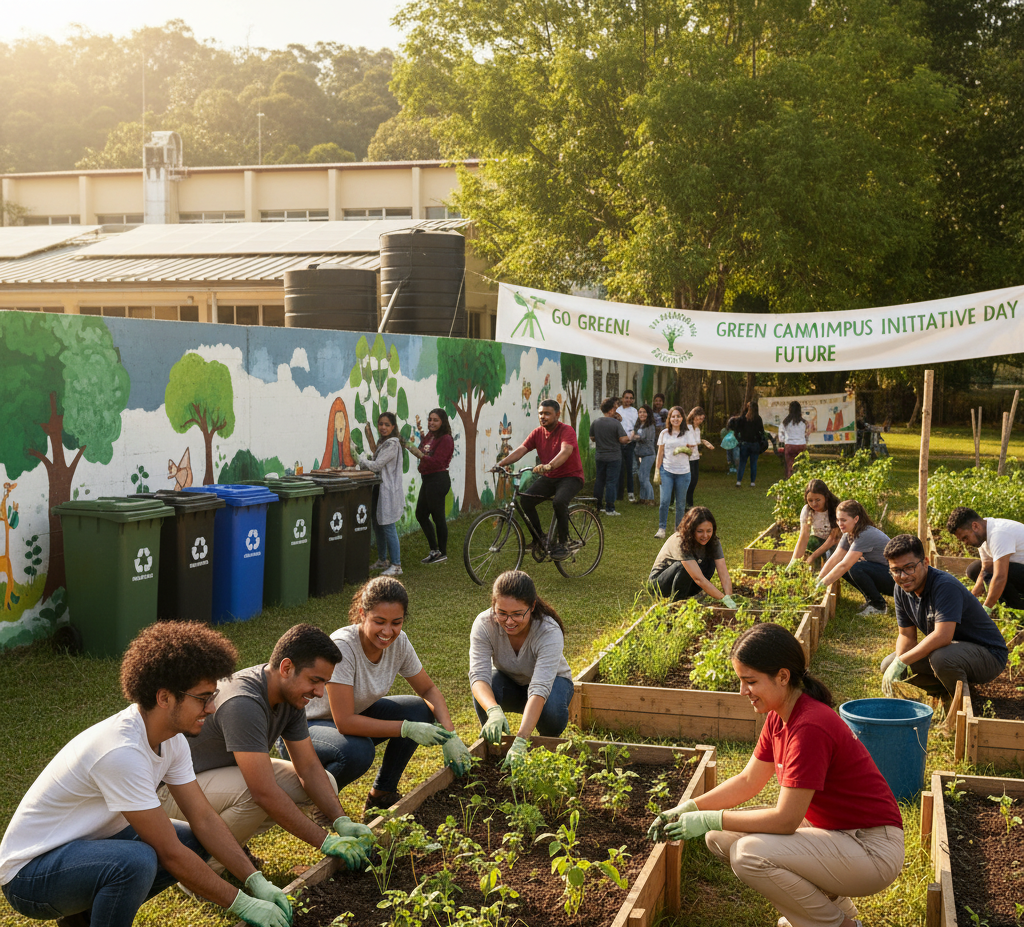How Student Engagement Can Transform Campus Sustainability

Your first step to a greener, smarter campus.
- September 30, 2025
- Karthiga S
When Campus Green Audits Fall Short
On many college campuses, sustainability looks flawless on paper. Policies are documented, checklists are followed, and green audit submissions appear thorough. Yet behind the reports, the real action often falls short. Classrooms are left with lights on, waste isn’t segregated properly, and water conservation habits rarely extend beyond reminders on posters.
This is a common challenge: campus green audits alone cannot drive real change. Infrastructure and policies provide a framework, but without active student engagement in sustainability, the impact remains temporary and audits become a formality rather than a catalyst for transformation.
In fact, student participation is now a critical focus area for NAAC, ESG, and Green Audit assessments. Engaged students don’t just follow rules — they innovate, influence peers, and help build a culture of sustainability that lasts far beyond inspection days.
The Power of Student Engagement in Campus Sustainability
Students are the driving force behind a campus’s environmental impact. Their daily actions — switching on lights, operating lab equipment, using water, and generating waste in hostels and canteens — directly shape a college’s energy consumption, waste footprint, and water usage.
When students are actively engaged, sustainability evolves from a mere compliance requirement into a living campus culture. They become changemakers, influencing peers and ensuring that green initiatives are consistently practiced rather than temporarily implemented for audits.
At Aspira, we’ve observed that colleges with strong student participation in green audits, energy conservation programs, and waste reduction initiatives experience measurable results:
- Reduced electricity consumption through student-led campaigns
- Lower waste generation with proper segregation and reuse
- Cost savings in water, energy, and materials
Real, Practical Strategies for Student-Led Sustainability
Sustainability doesn’t have to be a top-down mandate. In fact, the most successful green campuses are those where students take ownership of environmental initiatives. On Indian campuses, small, well-structured actions can lead to measurable improvements in energy efficiency, waste management, and water conservation, while also strengthening NAAC, Green Audit, and ESG performance.
Green Champions: Students Leading the Way
One of the most effective strategies is appointing student “green champions” in every department or hostel. These champions become the point of accountability for energy, waste, and water practices.
They monitor lights, fans, and lab equipment to ensure nothing is left running unnecessarily, guide their peers on proper waste segregation, and organize mini awareness campaigns — like a short weekly session on reducing single-use plastics or conserving water in hostels.
Recognizing these champions in campus newsletters, notice boards, or during events not only motivates them but also inspires other students to participate. Over time, these champions become catalysts for peer-driven sustainability, creating tangible results that can be documented for audits.
Switch-Off & BYO Campaigns: Simple Actions, Big Results
Small campaigns can lead to significant environmental impact. Monthly “switch-off drives” in classrooms, laboratories, and hostels have been shown to reduce electricity consumption by measurable percentages, while simultaneously raising awareness about energy conservation.
Complementing this with BYO (Bring Your Own) campaigns — encouraging students to bring reusable bottles, cups, and cutlery — helps drastically reduce single-use plastics. These are low-cost, high-impact initiatives that are easy to implement and track, providing clear evidence for NAAC or Green Audit submissions.
Waste Segregation Volunteers: Peer Accountability in Action
Assigning students as waste segregation volunteers or “bin guides” during lunch hours or college events ensures proper disposal and recycling of waste. Peer-led monitoring tends to be more effective than administrative supervision, as students are more likely to follow guidance from fellow students.
Volunteers can also maintain simple logs of recyclable and non-recyclable waste, which becomes measurable documentation for audits while simultaneously educating the campus community on responsible disposal.
Sustainability Dashboards & Visibility
Making sustainability visible can transform behavior. A monthly updated dashboard or notice board highlighting energy and water savings, waste reduction, or tree plantation initiatives provides motivation for students and staff alike. It also creates transparent, trackable metrics that can be directly used in NAAC and Green Audit reporting. When students see the tangible results of their efforts, engagement increases, creating a cycle of sustained participation.
Green Protocols for Campus Events
Cultural festivals, academic fests, and sports events are often high-waste activities. By having students define and enforce eco-friendly guidelines — such as using reusable or paper-based décor, setting up clearly labeled recycling stations, and minimizing single-use plastics — campuses can drastically cut environmental impact. These student-led initiatives are highly visible, easily replicable, and provide concrete evidence for audit submissions.
Green Credit Systems: Rewarding Participation
Incentivizing students through “green credits” for sustainability activities — tree planting, awareness drives, clean-up campaigns, or workshops — encourages long-term engagement. These credits can be incorporated into co-curricular or internal assessment records, creating a formal recognition system that reinforces participation and contributes to NAAC and Green Audit documentation.
Impact and Outcomes
Together, these strategies do more than just meet compliance requirements. They create a culture of sustainability, improve measurable environmental metrics, and foster a generation of students who carry eco-conscious habits beyond campus. From energy reduction and water conservation to waste minimization and eco-friendly event management, student-led initiatives provide tangible, trackable results that strengthen audit outcomes and campus sustainability credentials.
Measurable Impact of Student-Led Sustainability
When students are actively involved, the impact becomes tangible and measurable. For example, campuses implementing student-led energy conservation campaigns often report 10–12% reduction in electricity consumption within a single semester. Similarly, proper waste management initiatives guided by student volunteers can divert hundreds of kilograms of waste from landfills during festivals or semester-long activities. Beyond these metrics, engagement in eco-clubs, awareness drives, and green campaigns significantly increases student participation in sustainability initiatives, creating a ripple effect across classrooms, hostels, and event spaces.
These results do more than just improve numbers on paper. They strengthen performance in NAAC and Green Audits, provide clear, trackable evidence for ESG reporting, and — most importantly — instill a lasting culture of responsibility and environmental stewardship that persists long after inspections are over.
Sustainability Through Student Leadership
Sustainability on campus is not just a matter of infrastructure upgrades or compliance checklists—it is a matter of culture. Real progress happens when students themselves are engaged as the drivers of change. By giving them responsibility, resources, and recognition, institutions turn sustainability from a project into a practice.
When students lead, conservation and eco-friendly habits become second nature. Energy and water are used wisely, waste is managed responsibly, and sustainable choices extend into events, academics, and daily life. This is how sustainability moves beyond policy into identity—defining the campus and setting a standard that others aspire to follow.
Post Tags :
About Us
We are a team of certified professionals with expertise in green audits and Hygiene Rating Audits, driven by industry standards and sustainability best practices. Our comprehensive inspection services help institutions and businesses improve environmental performance, enhance hygiene compliance, and align with national and global standards.





